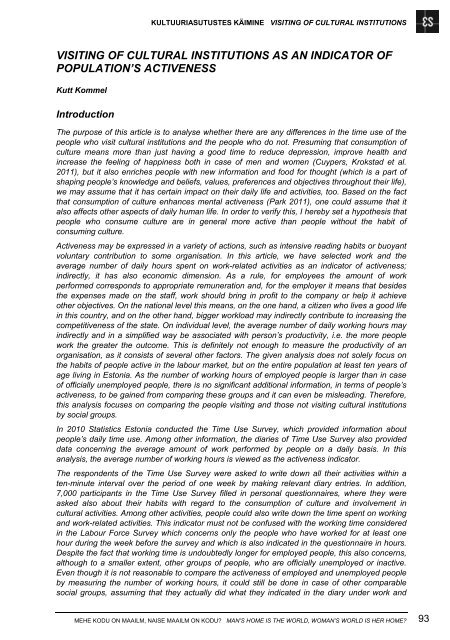MEHE KODU ON MAAILM, NAISE MAAILM ON KODU? - Tartu Ãlikool
MEHE KODU ON MAAILM, NAISE MAAILM ON KODU? - Tartu Ãlikool
MEHE KODU ON MAAILM, NAISE MAAILM ON KODU? - Tartu Ãlikool
You also want an ePaper? Increase the reach of your titles
YUMPU automatically turns print PDFs into web optimized ePapers that Google loves.
KULTUURIASUTUSTES KÄIMINE VISITING OF CULTURAL INSTITUTI<strong>ON</strong>S<br />
VISITING OF CULTURAL INSTITUTI<strong>ON</strong>S AS AN INDICATOR OF<br />
POPULATI<strong>ON</strong>’S ACTIVENESS<br />
Kutt Kommel<br />
Introduction<br />
The purpose of this article is to analyse whether there are any differences in the time use of the<br />
people who visit cultural institutions and the people who do not. Presuming that consumption of<br />
culture means more than just having a good time to reduce depression, improve health and<br />
increase the feeling of happiness both in case of men and women (Cuypers, Krokstad et al.<br />
2011), but it also enriches people with new information and food for thought (which is a part of<br />
shaping people’s knowledge and beliefs, values, preferences and objectives throughout their life),<br />
we may assume that it has certain impact on their daily life and activities, too. Based on the fact<br />
that consumption of culture enhances mental activeness (Park 2011), one could assume that it<br />
also affects other aspects of daily human life. In order to verify this, I hereby set a hypothesis that<br />
people who consume culture are in general more active than people without the habit of<br />
consuming culture.<br />
Activeness may be expressed in a variety of actions, such as intensive reading habits or buoyant<br />
voluntary contribution to some organisation. In this article, we have selected work and the<br />
average number of daily hours spent on work-related activities as an indicator of activeness;<br />
indirectly, it has also economic dimension. As a rule, for employees the amount of work<br />
performed corresponds to appropriate remuneration and, for the employer it means that besides<br />
the expenses made on the staff, work should bring in profit to the company or help it achieve<br />
other objectives. On the national level this means, on the one hand, a citizen who lives a good life<br />
in this country, and on the other hand, bigger workload may indirectly contribute to increasing the<br />
competitiveness of the state. On individual level, the average number of daily working hours may<br />
indirectly and in a simplified way be associated with person’s productivity, i.e. the more people<br />
work the greater the outcome. This is definitely not enough to measure the productivity of an<br />
organisation, as it consists of several other factors. The given analysis does not solely focus on<br />
the habits of people active in the labour market, but on the entire population at least ten years of<br />
age living in Estonia. As the number of working hours of employed people is larger than in case<br />
of officially unemployed people, there is no significant additional information, in terms of people’s<br />
activeness, to be gained from comparing these groups and it can even be misleading. Therefore,<br />
this analysis focuses on comparing the people visiting and those not visiting cultural institutions<br />
by social groups.<br />
In 2010 Statistics Estonia conducted the Time Use Survey, which provided information about<br />
people’s daily time use. Among other information, the diaries of Time Use Survey also provided<br />
data concerning the average amount of work performed by people on a daily basis. In this<br />
analysis, the average number of working hours is viewed as the activeness indicator.<br />
The respondents of the Time Use Survey were asked to write down all their activities within a<br />
ten-minute interval over the period of one week by making relevant diary entries. In addition,<br />
7,000 participants in the Time Use Survey filled in personal questionnaires, where they were<br />
asked also about their habits with regard to the consumption of culture and involvement in<br />
cultural activities. Among other activities, people could also write down the time spent on working<br />
and work-related activities. This indicator must not be confused with the working time considered<br />
in the Labour Force Survey which concerns only the people who have worked for at least one<br />
hour during the week before the survey and which is also indicated in the questionnaire in hours.<br />
Despite the fact that working time is undoubtedly longer for employed people, this also concerns,<br />
although to a smaller extent, other groups of people, who are officially unemployed or inactive.<br />
Even though it is not reasonable to compare the activeness of employed and unemployed people<br />
by measuring the number of working hours, it could still be done in case of other comparable<br />
social groups, assuming that they actually did what they indicated in the diary under work and<br />
<strong>MEHE</strong> <strong>KODU</strong> <strong>ON</strong> <strong>MAAILM</strong>, <strong>NAISE</strong> <strong>MAAILM</strong> <strong>ON</strong> <strong>KODU</strong>? MAN’S HOME IS THE WORLD, WOMAN’S WORLD IS HER HOME? 93

















